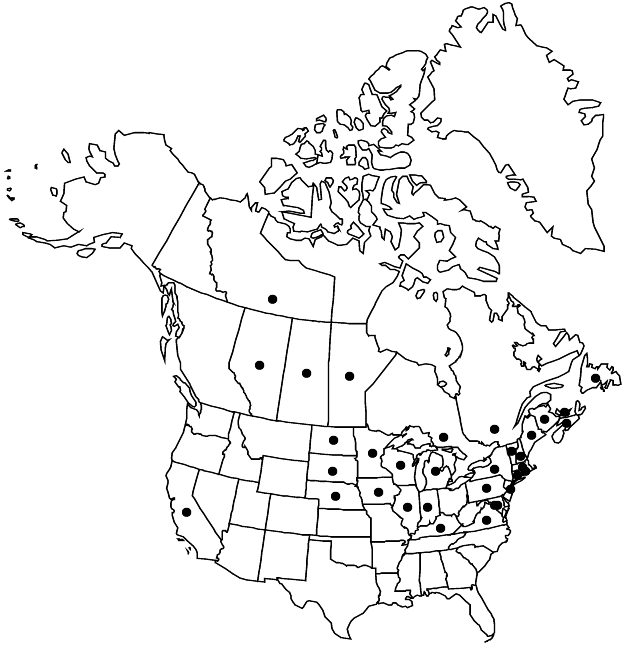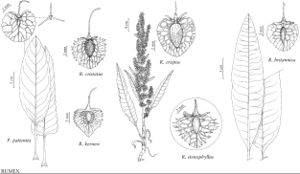Rumex britannica
Sp. Pl. 1: 334. 1753.
Plants perennial, normally glabrous or very indistinctly papillose on veins of leaf-blades abaxially, with fusiform, vertical rootstock. Stems erect, branched distal to middle, 80–150 (–200) cm. Leaves: ocrea deciduous or partially persistent at maturity; blade lanceolate or oblong-lanceolate, normally 20–55 (–70) × 2–7 cm, base cuneate, occasionally rounded or truncate, margins entire, flat to slightly crisped, apex acute. Inflorescences terminal, occupying distal 1/2 of stem, dense or interrupted in proximal 1/2, broadly paniculate, branches usually straight or arcuate. Pedicels articulated in proximal 1/3, filiform, 5–13 mm, articulation barely evident, not distinctly swollen. Flowers 15–25 in whorls; inner tepals orbiculate or orbiculate-ovate, rarely ovate-deltoid, 4–7 (–7.5) × 3.5–7 mm, base truncate or slightly cordate, margins entire or weakly erose, flat, apex obtuse to subacute; tubercles 3, equal or subequal, normally less than 2 times as wide as inner tepals. Achenes usually reddish-brown, 3–4.5 × 1.5–2.5 mm. 2n = 20.
Phenology: Flowering late spring–summer.
Habitat: Marshes, shores, wet meadows, other damp areas
Elevation: 0-1500 m
Distribution

Alta., Man., N.B., Nfld. and Labr. (Nfld.), N.W.T., N.S., Ont., P.E.I., Que., Sask., Calif., Conn., D.C., Ill., Ind., Iowa, Ky., Maine, Md., Mass., Mich., Minn., Nebr., N.H., N.J., N.Y., N.Dak., Pa., R.I., S.Dak., Vt., Va., Wis.
Discussion
The name Rumex orbiculatus commonly was applied to this North American species. After study of the Linnaean type of R. britannica, J. E. Dawson (1979) concluded that that name is the earliest valid one for this taxon.
In early North American floristic literature, Rumex britannica commonly was misidentified as R. hydrolapathum Hudson, a closely related European species also belonging to subsect. Hydrolapatha Rechinger f. (K. H. Rechinger 1937); that species differs from R. britannica in having more triangular inner tepals with an acute apex. The name R. acutus Linnaeus was misapplied to R. britannica by W. J. Hooker ([1829–] 1833–1840, vol. 2) and other botanists.
Disjunct populations have been reported from California and Louisiana. The California record (from Plumas County) was confirmed by J. E. Dawson (1979); the records from Louisiana need confirmation.
Selected References
None.
Lower Taxa
"/2" is not declared as a valid unit of measurement for this property.
